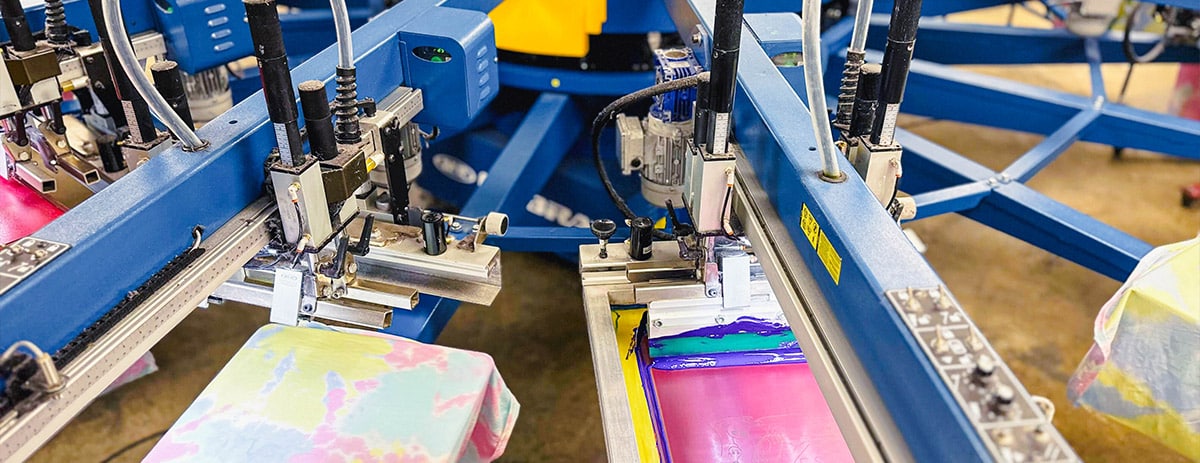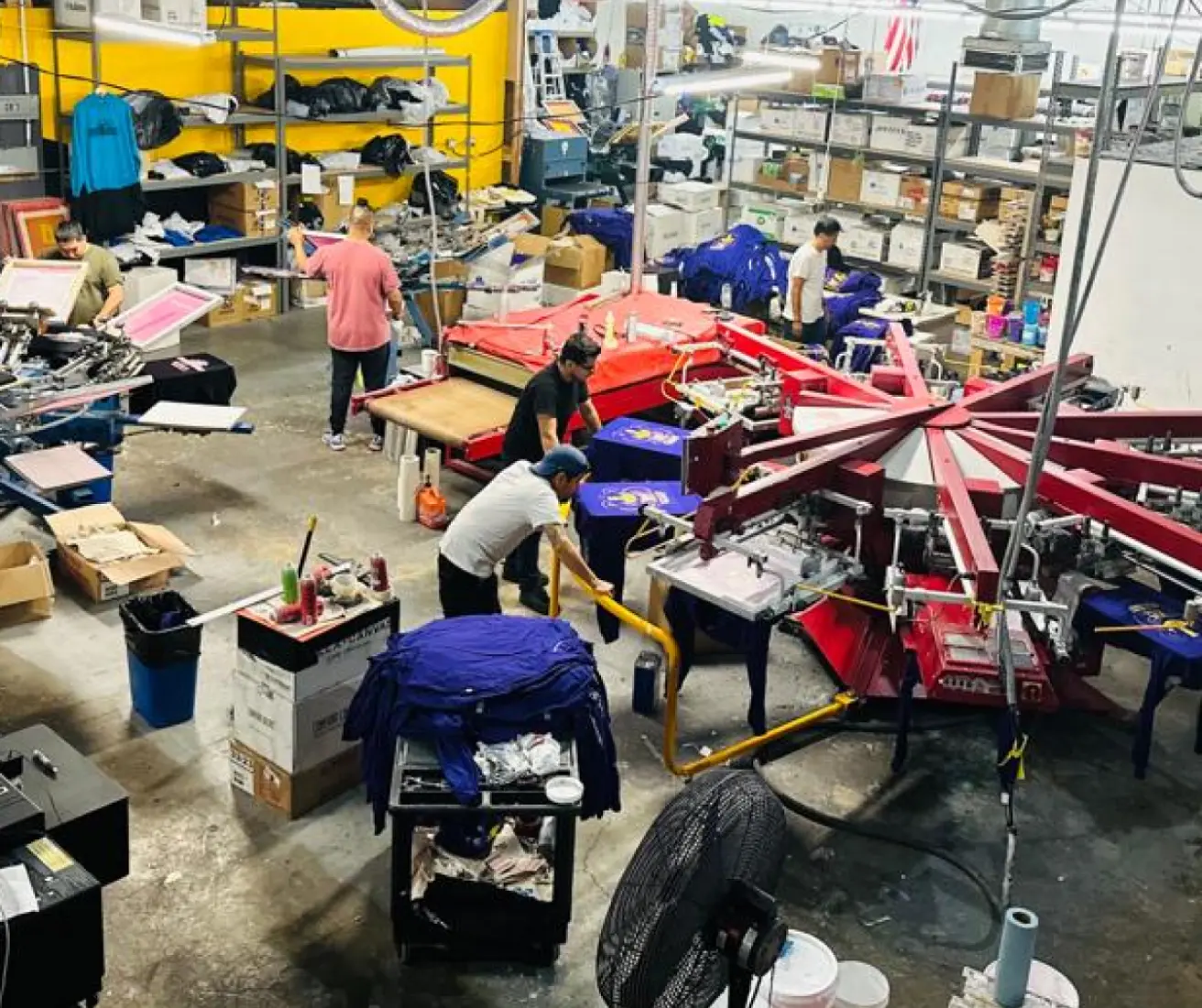Screen Printing Uncovered: Whatever You Required to Learn About Tee Shirt and Garment Printing Techniques
If you've ever before wondered how those vibrant designs wind up on your favored tees, you remain in the appropriate place. Screen printing is an interesting technique that integrates art with strategy, using countless opportunities for imagination. Recognizing the principles, from equipment to ink selections, can considerably influence your results. Prepared to discover the important elements that make screen printing an art type? Let's uncover the details that can elevate your jobs.
The Basics of Display Printing: Exactly How It Functions
When you plunge right into display printing, you'll discover it's both a science and an art. At its core, display printing entails producing a stencil, or screen, that permits ink to pass with only in details areas.
Position the screen over the fabric, then make use of a squeegee to push ink through the screen onto the garment. Each action is important, and understanding them will raise your screen printing abilities, changing simple garments right into one-of-a-kind, expressive pieces.
Sorts Of Screen Printing Strategies
As soon as you realize the fundamentals of display printing, it's time to discover the various techniques that can elevate your designs. One prominent method is conventional display printing, where ink is pushed with a stenciled screen. This method is terrific for strong, vibrant colors. Then there's water-based ink printing, which supplies a softer feeling and is green, however it calls for a different strategy to treating.
An additional choice is plastisol printing, recognized for its longevity and brilliant colors, making it a favorite for many brand names. Experiment with halftone printing to produce gradient effects and intricate layouts.
Necessary Equipment for Display Printing
To attain spectacular lead to screen printing, having the right devices is basic. First, you'll require a durable display printing framework, which holds the mesh that transfers your style onto the garment. Next off, buy top quality mops; these are important for using ink equally throughout the screen. You'll likewise need a great exposure system to create your displays, as well as a washout booth for cleansing them after usage. A reliable warm resource, like a conveyor dryer or warm press, is important for curing your prints to assure durability. Do not neglect a proper workspace, outfitted with tables and storage for your materials. Safety equipment, such as masks and gloves, will certainly maintain you safe from chemicals and inks. With the right devices, you'll be well on your means to producing professional-quality prints.
Picking the Right Inks and Products
When picking inks and products for screen printing, you need to think about the kind of ink that works best for your project. Think about fabric compatibility to guarantee your styles look last and terrific long. Also, discover environmentally friendly ink choices to make your printing process much more sustainable.
Sorts Of Display Inks
Selecting the ideal screen ink is important for achieving vibrant, durable prints that fulfill your job's demands. There are a number of types of display inks to take a look at. Plastisol ink is prominent for its adaptability and ease of usage, supplying superb shade opacity on dark materials. Water-based ink, on the various other hand, uses a softer feeling and is environment-friendly, making it perfect for those wanting to decrease their ecological effect. Discharge inks get rid of dye from the fabric, causing a soft, vintage appearance but need particular handling. Specialized inks, such as glow-in-the-dark or metallic, can include distinct effects to your styles. Evaluate your project needs and choose the ink that straightens best with your preferred end result.

Textile Compatibility Considerations
Understanding textile compatibility is crucial for achieving top notch display prints, especially considering that different materials respond uniquely to numerous inks. Always test your inks on example material to assure they adhere properly and preserve color honesty. Furthermore, maintain in mind that material weight and structure can affect the final end result, so picking the best ink and material combination is vital for your project's success.
Eco-Friendly Ink Options
Eco-friendly inks are ending up being a popular choice for screen printers who want to lessen their ecological influence while maintaining quality. When choosing inks, consider water-based inks, which are less damaging and much easier to cleanse up contrasted to standard solvents.
In addition, seek inks made from renewable energies, such as soy or vegetable-based alternatives. By choosing the right inks and products, you'll not just develop sensational layouts yet additionally add to a more sustainable printing process. Make the switch, and your prints will reflect your dedication to the environment!
Preparing Your Style for Screen Printing

File Style Needs
To ensure your layout looks vivid and sharp on fabric, you'll need to pay close focus to file layout requirements for display printing. Begin with vector files like AI or EPS, as they can be scaled without losing top quality. If you use raster pictures, select high-resolution data, such as TIFF or PNG, preferably at 300 DPI. Stay clear of using JPEGs, as they can lose clearness when resized. Make certain your design has a transparent history to avoid undesirable white sides on your prints. Finally, keep color settings in mind; CMYK is basic for screen printing, so convert your RGB creates accordingly. By following these guidelines, you'll establish your art work up for an effective print.
Color Separation Strategies
Color separation is a necessary step in preparing this page your design for display printing, and grasping it can considerably enhance your print top quality. You'll need to break your layout into specific colors, as each shade needs a separate display during printing. This precision not just ensures precise shade representation yet also streamlines the printing procedure.
Resolution and Size
Achieving the most effective cause display printing starts with guaranteeing your style has the appropriate resolution and size. Preferably, your artwork needs to go to least 300 DPI (dots per inch) for sharp, clear prints. If you use lower resolution, your last product could look pixelated and amateur.
When it pertains to dimension, consider the measurements of your print area. Layout your art work to match the final print size, ideally developing it in the actual measurements you'll be publishing. This method, you'll avoid any type of unanticipated scaling issues.
Constantly check your layout in both vector and raster formats. Vector graphics can be scaled without losing high quality, making them ideal for display printing. Preparing correctly will ensure your style looks incredible on every garment!
Step-by-Step Screen Printing Refine
Screen printing is a dynamic process that enables you to produce lively styles on different surfaces. To get started, you'll need a display, solution, and your selected ink.
After rinsing the unexposed solution, your display prepares. Set it up on your printing surface area and straighten your garment beneath it. Pour ink onto the display and use a squeegee to press the ink through the pattern onto the material. Raise the screen meticulously and let the print completely dry. Treat the ink using warmth to assure resilience. That's it! You've effectively display published your style.
Tips for Effective Display Printing Projects
While you're diving right into your display printing jobs, keep in mind that preparation is key to success. Beginning by collecting all your materials-- inks, displays, garments, and mops. A tidy workspace aids stop unwanted errors, so clean up before you start.
Next, verify your art work is high-resolution and correctly sized for your garment. Evaluate your screen for correct direct exposure and clean it completely to avoid smudges. When mixing your inks, adhere to the maker's standards to accomplish the ideal consistency.
During printing, use even pressure with your squeegee for regular results. Don't hurry; take your time to confirm each print fulfills your requirements. After printing, let your garments completely dry completely prior to taking care of or packaging them.
Last but not least, constantly maintain a sample of your job for future referral. In this manner, you can evaluate your development and helpful resources enhance your techniques over time. Pleased printing!

Often Asked Concerns
How much time Does It Require To Set up a Screen Printing Job?
Setting up a display printing work normally takes around 30 minutes to an hour. You'll prepare the screens, mix inks, and adjust journalism. The time differs based upon intricacy and experience, so stay organized!
Can I Print on Different Fabric Enters Using the Same Strategy?
Yes, you can publish on various textile types making use of the exact same strategy, however you'll need to change your setups and inks. Some materials absorb ink in different ways, so trying out guarantees the very best results for every material.
What Are Typical Blunders to Stay Clear Of in Display Printing?
When display printing, prevent typical errors like utilizing the incorrect ink, overlooking proper direct exposure times, or skipping pre-press checks. Constantly test your arrangement and maintain clean screens to guarantee high quality outcomes each time.
Exactly How Can I Effectively Clean and Keep My Screen Printing Tools?
To properly clean and maintain your screen printing equipment, you must on a regular basis wash displays with ideal solvents, examine mops for wear, and assure all devices are saved dust-free and completely dry. Consistency stops pricey repairs and improves efficiency.
Is Display Printing Eco Friendly Compared to Other Techniques?
Display printing can be more eco-friendly than various other techniques, especially if you make use of water-based inks and eco-conscious materials. By picking sustainable supplies and practices, you reduce waste and reduce your influence on the earth.
Display Printing Uncovered: Everything You Required to Know About T-Shirt and Garment Printing Strategies
At its core, screen printing entails producing a pattern, or screen, that permits ink to pass with just in specific areas. Position the display over the material, then make use of a squeegee to press ink with the screen onto the garment. One prominent approach is traditional screen printing, where ink is pushed via a stenciled screen.When picking inks and products for screen printing, you require to official source take right into account the kind of ink that works finest for your project.